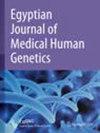Emanuel syndrome due to unusual pattern
IF 1.2
Q4 GENETICS & HEREDITY
引用次数: 0
Abstract
The hallmarks of Emanuel syndrome are pre- and postnatal growth retardation, microcephaly, global developmental delay, ear anomalies, and in males, heart, kidney, and genital abnormalities. This study describes the atypical features of Emanuel syndrome, a rare chromosomal disorder. The patient had several physical features that are common in Emanuel syndrome, such as microcephaly, hypotonia, and ear anomalies. However, he exhibited certain unusual characteristics, including the lack of a prominent forehead, epicanthic folds, and a downward slanting palpebral fissure. There was infratentorial brain involution with a minor infarction in the left cerebral hemisphere and cerebellar hypoplasia on the magnetic resonance imaging (MRI) scan of the brain. Additionally, the patient had bilateral mild hearing loss and an aberrant epileptogenic pattern on the electroencephalogram (EEG). Orodental examination showed a long philtrum, everted fissured thick lower lip, highly attached labial frenum, and prominent median palatine raphe. The karyotype revealed 45XY t(11;22)(p15.5;q11.22), which is different from the typical karyotype of Emanuel syndrome. This case sheds light on the possibility of alternative genetic mechanisms, beyond chromosomal abnormalities, in patients presenting with multiple congenital anomalies and facial dysmorphism.异常模式导致的伊曼纽尔综合征
伊曼纽尔综合征的特征是产前和产后生长迟缓、小头畸形、全面发育迟缓、耳部异常,男性还伴有心脏、肾脏和生殖器异常。本研究描述了伊曼纽尔综合征这一罕见染色体疾病的非典型特征。患者有几个伊曼纽尔综合征常见的身体特征,如小头畸形、肌张力低下和耳部异常。但他表现出一些不寻常的特征,包括没有突出的前额、上睑皱褶和向下倾斜的睑裂。脑部磁共振成像(MRI)扫描显示,他的左侧大脑半球有轻微脑梗塞和小脑发育不全。此外,患者双侧听力轻度下降,脑电图(EEG)显示异常致痫模式。口腔检查显示,患者的咽鼓管较长,下唇厚而外翻,唇缘高度附着,腭中剑突突出。核型显示为 45XY t(11;22)(p15.5;q11.22),与伊曼纽尔综合征的典型核型不同。该病例揭示了染色体异常以外的其他遗传机制在多发性先天性畸形和面部畸形患者中的可能性。
本文章由计算机程序翻译,如有差异,请以英文原文为准。
求助全文
约1分钟内获得全文
求助全文
来源期刊

Egyptian Journal of Medical Human Genetics
Medicine-Genetics (clinical)
CiteScore
2.20
自引率
7.70%
发文量
150
审稿时长
18 weeks
 求助内容:
求助内容: 应助结果提醒方式:
应助结果提醒方式:


